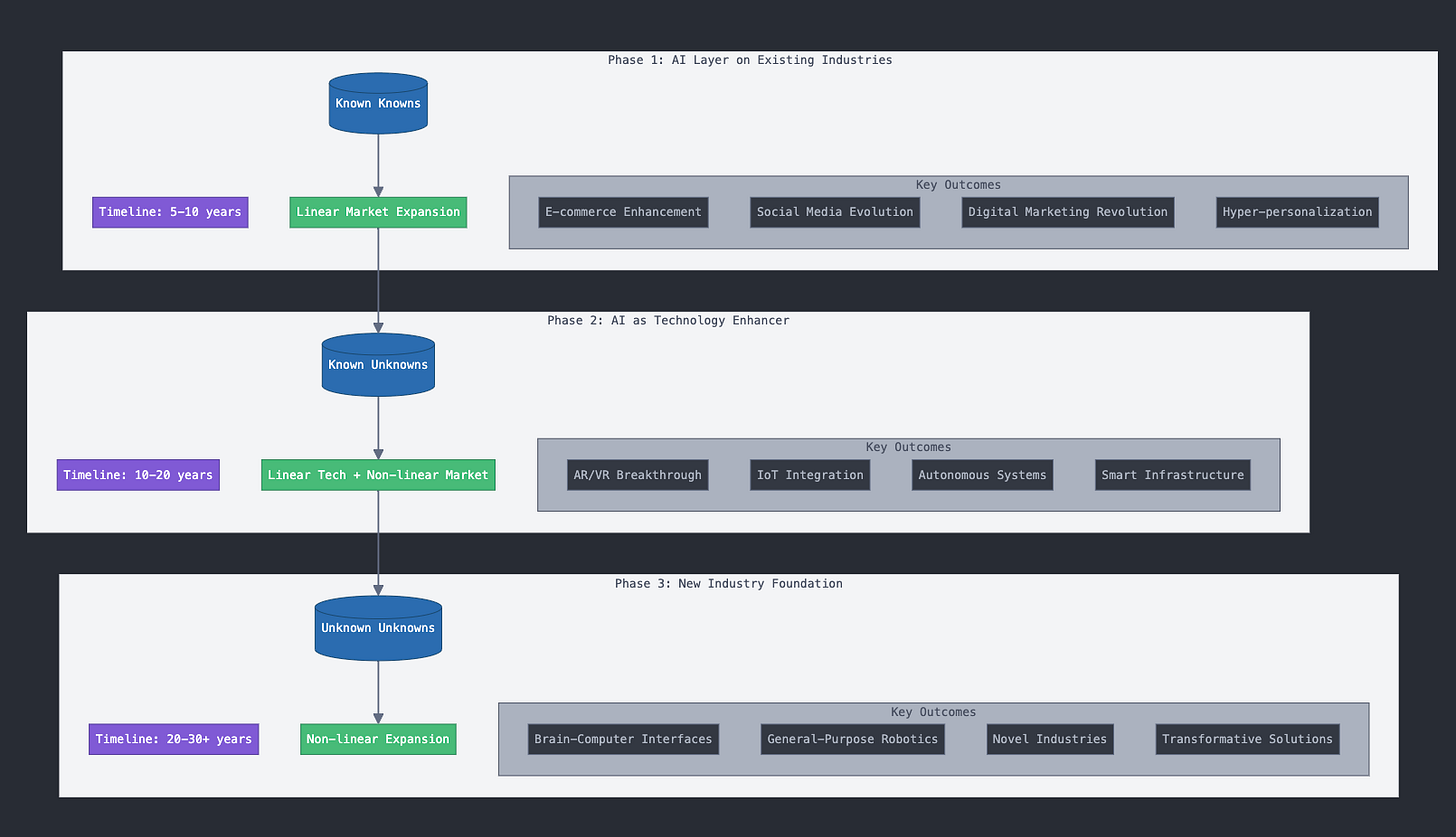The Web²
Market expansion theory is a mental model that tells you the difference between a gradual technology and a paradigm shift.
A paradigm shift happens when a technology works as a layer on top of everything built before to expand it to new heights.
Several consequences are attached to the market expansion theory.
For instance, market expansion theory tells you that you will see this happening in three phases or macrocycles:
Phase 1: A layer on top of every existing industry (known knowns) - defined by linear technology and market expansion.
Phase 2: An enhancer for many developing/complementary industries (known unknowns) - defined by linear technology expansion, only partially linear market expansion, and non-linear market expansion.
Phase 3: The foundation for creating whole new emerging industries viable (unknown unknowns) - defined as fully non-linear technology/market expansion.
For this issue, I’ll focus only on Phase 1. The interesting aspect here is phase 1 predicts incumbents will initially make the most of this first wave. De facto, turning themselves into the primary beneficiaries of this wave. But this might be mostly a temporary effect.
Over time, native companies of this new paradigm will dominate the market. Some incumbents will survive only because they have embraced the new paradigm.
Back to AI, this is a paradigm shift, in line with market expansion theory, because AI will work as a “computing layer on top” of every industry created throughout the web era.
The interesting take here is that the Web had to go through a cycle of development that lasted 30 years.
Yet, the AI cycle might probably last 30-50 years. For a simple reason, this might be more powerful to the web cycle, as it might be more similar to the “microprocessor,” which transformed everything it touched from the 1970s to the 2010s (the CPU is still a core component of your smartphone).

With a core difference, this will be an "Intelligence Revolution,” where AI, as the “computing layer on top,” will enable a sort of “Cognitive Automation,” which will be imbued initially into a few core industries at lower value-add first, like customer support, and move its way up from there!
That doesn't mean all incumbents will disappear.
It simply means we'll see a reshuffling of the competitive landscape (in 10-30 years), with new players dominating the market, incumbents who will have changed skin (e.g., Google might be around as Alphabet but dominating a different industry than search); and new industries which will have expanded the previous ones by many times over.
The Web²: The AI-Expanded Web
And that process might require 5-10 years to kick off!
In this issue, I’m only introducing the concept, as in the upcoming Saturday issue, I’ll touch in detail about what I like to call The Web².
Market Expansion Theory In Action In The AI Era
Over the years, among the Business Engineer’s core concepts, I’ve developed the idea of “Transitional Business Models,” which sits on top of the concept of “transitional market expansion theory.”
Transitional market expansion theory looks at the world as a dynamic environment.
It tells you that various markets developed during a “transitional paradigm” will only work temporarily, as they get displaced from something else that will expand on top yet completely redefine the previous era.
In the initial phase, the rule of thumb is “niche down to scale up.”
New players are coming to the market leveraging “market niches” as entry points (reality checks) to enable a first phase of scale.
The niche is tightly connected to the scaling phase because it’s where the market discovery process happens. Indeed, compared to scaled-up markets, niches work on tighter feedback loops, which set the stage for scale. Indeed, during this market discovery process, a company will experience various options to scale.
As a quick preview of what we’ll see on a larger issue on the topic, these are some of the market expansions we’re looking at in the AI era:
Recap: In This Issue!
Market Expansion Theory Framework:
Distinguishes between gradual technology changes and paradigm shifts
A paradigm shift occurs when technology acts as a layer expanding everything built before
Develops in three distinct phases/macrocycles from known to unknown territories
AI Timeline and Impact:
Expected to have a 30-50 year cycle, longer than the web's 30-year cycle
Comparable to the microprocessor revolution (1970s-2010s) in terms of impact
Will enable "Cognitive Automation" starting with lower value-add industries
Competitive Landscape Evolution:
Initial Phase: Incumbents are primary beneficiaries
Long-term: Native companies built on the new paradigm will dominate
Some incumbents will survive by fully embracing the new paradigm
Example: Google might exist as Alphabet but dominate different industries
Transitional Market Theory:
Markets develop during "transitional paradigms"
Initial rule: "niche down to scale up"
Niches serve as entry points and reality checks
Tight feedback loops in niches enable market discovery
First Phase Characteristics:
Takes about 5-10 years to kick off
Incumbents can benefit initially but must adapt to new paradigm
Success requires more than just adopting technology
Must embrace underlying paradigm shift, even if it conflicts with current business model
Stay tuned for the upcoming piece to see the whole thing shaping up.
Ciao!
With ♥️ Gennaro, FourWeekMBA






